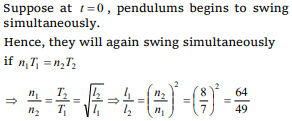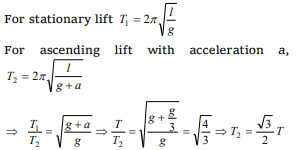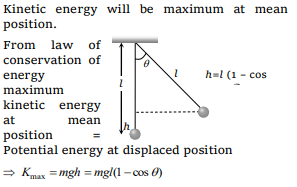1. The ratio of frequencies of two pendulums are 2 :
3, then their length are in ratio
a) \[\sqrt{2/3}\]
b) \[\sqrt{3/2}\]
c) \[4/9\]
d) \[9/4\]
Explanation:


2. Two pendulums begin to swing simultaneously. If
the ratio of the frequency of oscillations of the two is 7 : 8, then the ratio of lengths of the two
pendulums will be
a) 7 : 8
b) 8 : 7
c) 49 : 64
d) 64 : 49
Explanation:

3. A simple pendulum hanging from the ceiling of a
stationary lift has a time period \[T_{1}\] . When the lift
moves downward with constant velocity, the time
period is \[T_{2}\] , then
a) \[T_{2}\] is infinity
b) \[T_{2}>T_{1}\]
c) \[T_{2}< T_{1}\]
d) \[T_{2}=T_{1}\]
Explanation:

4.If the length of a pendulum is made 9 times and
mass of the bob is made 4 times then the value of
time period becomes
a) 3T
b) 3/2T
c) 4 T
d) 2 T
Explanation:

5. A simple pendulum is taken from the equator to
the pole. Its period
a) Decreases
b) Increases
c) Remains the same
d) Decreases and then increases
Explanation:

6. There is a simple pendulum hanging from the
ceiling of a lift. When the lift is stand still, the
time period of the pendulum is T. If the resultant
acceleration becomes g / 4, then the new time
period of the pendulum is
a) 0.8 T
b) 0.25 T
c) 2 T
d) 4 T
Explanation:

7. The period of a simple pendulum measured inside
a stationary lift is found to be T. If the lift starts
accelerating upwards with acceleration of
g / 3, then the time period of the pendulum is
a) \[\frac{T}{\sqrt{3}}\]
b) \[\frac{T}{3}\]
c) \[\frac{\sqrt{3}}{2}T\]
d) \[\sqrt{3}T\]
Explanation:

8. Time period of a simple pendulum will be double,
if we
a) Decrease the length 2 times
b) Decrease the length 4 times
c) Increase the length 2 times
d) Increase the length 4 times
Explanation:

9. Length of a simple pendulum is l and its maximum
angular displacement is \[\theta\], then its maximum K.E.
is
a) \[mgl \sin\theta\]
b) \[mgl \left(1+\sin\theta\right)\]
c) \[mgl \left(1+\cos\theta\right)\]
d) \[mgl \left(1-\cos\theta\right)\]
Explanation:

10. The velocity of simple pendulum is maximum at
a) Extremes
b) Half displacement
c) Mean position
d) Every where
Explanation: Mean position